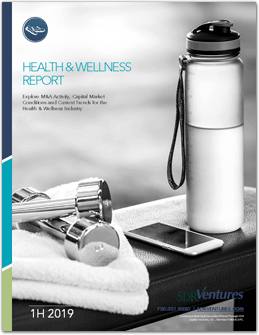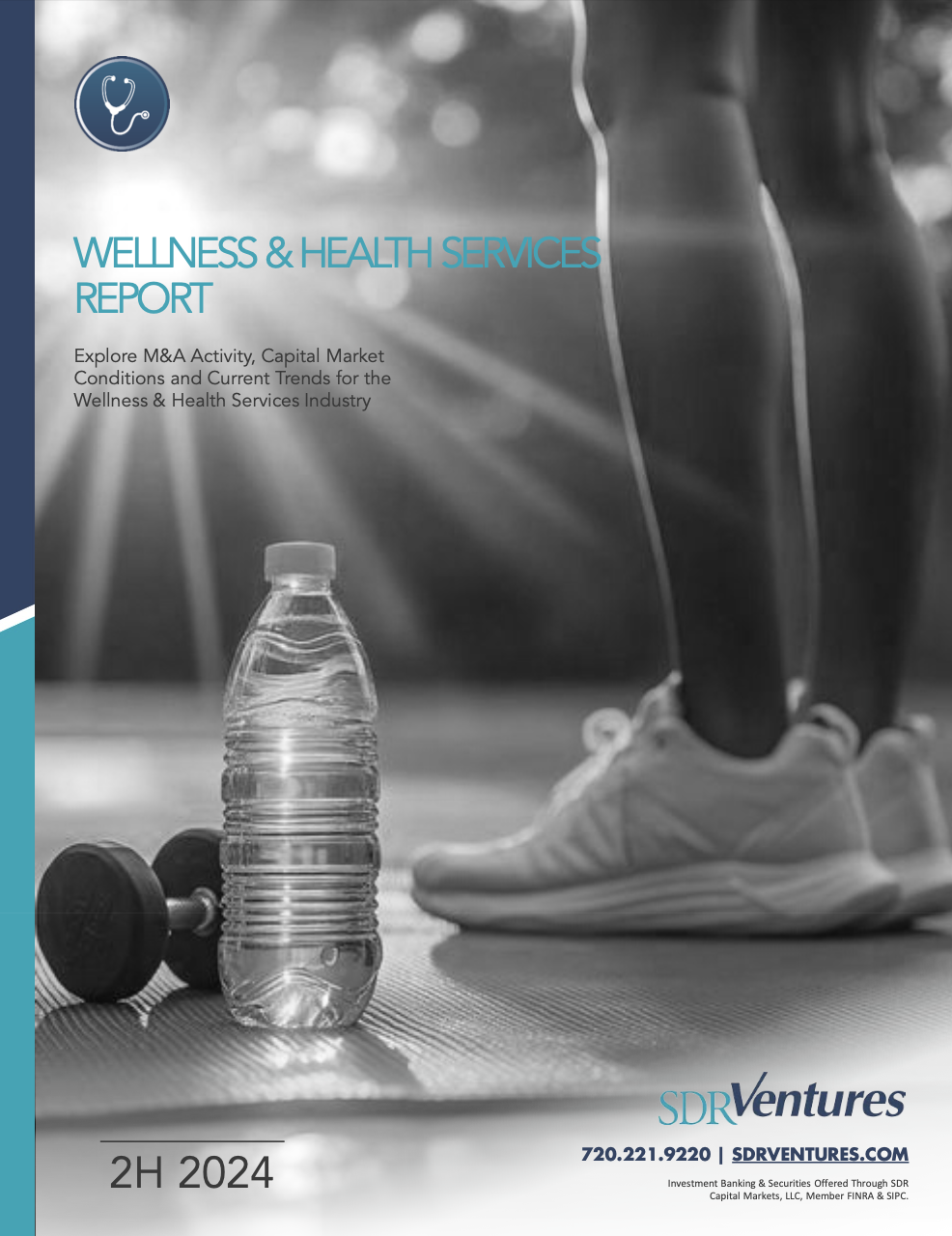2H 2024 Wellness & Health Services M&A Report

The Wellness & Health Services sector touches all of us in some way, whether that’s looking for a new bike helmet, knocking back an energy beverage, taking care of our skin, or considering a hip replacement. And the sector is always on the move. In 2H24 we were particularly interested in a few segments. In personal care and food, the new U.S. administration has been hinting at a focus on healthier living and snacking with a reduction in processed foods and some chemical ingredients. How that will guide public...
Previous Wellness & Health Services Reports
Wellness & Health Services is a broad category that touches all our lives. From supplements to medical care to exercise trends, we’ve seen plenty of activity, and for good reason. This category is all about who we are, how we care for ourselves and loved ones and, frankly, how we feel each day. Consumer spending in this sector is deeply personal. It’s estimated Americans spend $4.5 trillion a year on healthcare (doctors and such), about $13,500 per person annually, and another $5,300 a year each on “wellness,” including healthy eating, wearable tech, wellness tourism, and fitness…
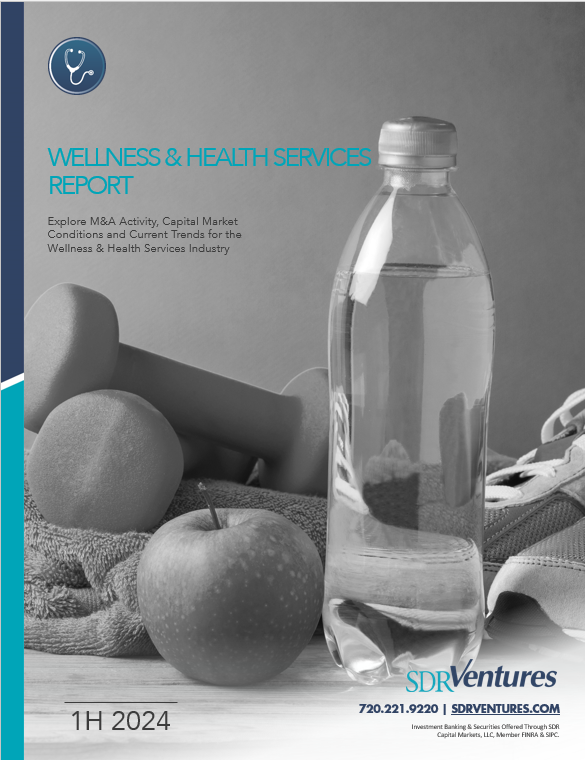
If two themes stood out in the broad Health and Wellness space in 2023, they were sleep care and weight loss. Specifically, pharmaceutically enabled weight loss and high-tech sleep care aids and therapies. It’s hard not to see the allure of getting a shot (or, in the future, a pill) to lose weight. Similarly, it’s easy to understand the renewed desire for better sleep in a post pandemic environment focused on self-care. Across the media landscape, good sleep is being positioned not as a nice-to-have but as a true healthcare issue. There’s even something called “sleep tourism” now. It’s not surprising research is showing we have more trouble sleeping as we age, and as the largest generation in the U.S. – Millennials – starts to hit their 40s, there’s a growing market.

If ever a segment depended on consumer sentiment, discretionary spending, and trends, it’s Health and Wellness. The COVID-19 pandemic refocused consumers on what’s going on in their bodies and staying healthy. The federal government’s reaction also pumped the U.S. economy with stimulus cash and provided financial relief to businesses. That stuff is over now. Instead of free money from Uncle Sam, consumers have seen prices at the store creep up with inflation and then the cost of borrowing – including credit cards – rise as the Fed jacks up interest rates to fight that inflation. Consumers can’t get a break, either deal with higher costs or higher credit card rates.

It was back to earth for the health & wellness industry in 2022. But there’s nothing wrong with earth. We’ve watched a pendulum swing from the start of the pandemic to the easing. Maybe we’re returning to the median. No worries, people have cared about their health & wellness since the witch doctor. Who doesn’t want to feel and look good, considering the alternative is feeling and looking bad. We believe this is a sector where people may adjust, trends come and go, but they never stop wanting to look, feel, and live better. Even as interest rates in 2022 rose and deals slowed, the sector remained nearly a half trillion-dollar industry globally, with the potential for 5% compound annual growth rates in the next few years.

The return to some form of normalcy after two years of masks, lockdowns, restrictions, and vaccines is shaking up the Health & Wellness Industry, and it’s happening fast. Maybe nowhere faster than in the fitness subsector, where gyms were hammered during the pandemic as people retreated to their homes, and in the home fitness market, where enthusiasts are rediscovering that they like being with other people at the gym instead of being stuck at home.
Following a busy 2021, M&A activity slowed in early 1H22, but there was a lot going on in the world and a lot to digest: a war in Europe, a struggling supply chain, stubborn inflation, and general uncertainly as we adjust away from COVID-era behaviors. As we left 2021 and entered 2022, fitness centers and studios that struggled during the depths of the pandemic appeared to rebound as gyms reported membership growth by 1Q22, though a recent survey shows “cleanliness” is in the top three factors when deciding on a membership.
Meanwhile, we are watching for the sticking power of at-home fitness businesses – including virtual classes and digitally connected equipment. Once dominant virtual cycling giant Peloton has ridden into hard times since its pandemic peak. And while people value gyms for their motivational and communal benefits, working at home was pretty convenient (but required a substantial investment). As physical gyms dabble in the home-fitness market, we may be looking at a hybrid future, something that’s neither the pre-pandemic after-work stop at the gym, or the stay-at-home and workout-by-video model…

As vaccines were administered and everyone hoped that life had begun its return to relative normalcy, SDR observed a couple of trends that help us gain further insight into M&A trends across the sector – one backward-looking, and one forward-looking. The two-year-old COVID pandemic has certainly focused consumer attention on overall individual wellness, spurring an interest in active living, mental health, and additive nutrition. At the same time, as employees continue to return to the workplace, go back to beauty salons and spas, and put away their sweatpants, SDR anticipates a resurgence in demand for cosmetic, hair care, and other beauty products.
Overall, 2H21 leaves us optimistic for the health & wellness industry as we saw a substantial uptick in sector-wide transaction activity: 53% above the same period one year prior. Acquisitions were up in activewear, natural and organic foods, and supplements with big spikes in personal care and outdoor products, up 63% and 125% respectively.
The personal care and cosmetics market alone is expected to reach $149 billion by 2025, growing at a compound annual growth rate (CAGR) of nearly 6% and driven largely by demand for “clean beauty” products rich in natural, healthy ingredients. Additionally, the pandemic-spurred gravitation towards the convenience of direct-to-consumer marketing and e-commerce retail shows no signs of fading. Old habits may be hard to break, but when it comes to consumers, new habits may also prove hard to break…
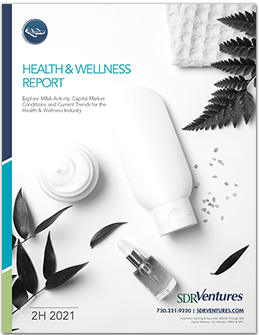
Perhaps there’s nothing like a mass contagion and streets filled with people wearing surgical masks to shock the system. If months of news conferences featuring the Surgeon General and hearing the words “ventilator” and “vulnerable population” won’t spur a renaissance in fitness and overall wellness, nothing will. As the world gets the vaccine and takes off its masks, we see opportunities in products and services that help people take better care of themselves. The Health & Wellness industry is center stage and in the spotlight.
In 1H21 we saw a continuing trend of interest in nutritional supplements (think probiotics, vitamins, and nutraceuticals) from both large consumer packaged goods (CPG) companies and private equity. We’re also watching how Health & Wellness product lines are leveraging brand recognition with direct-to-consumer online sales, bypassing third-party vendors. Gyms are reopening after a tumultuous year but are challenged by at-home fitness tech products, and employers that may have had an onsite gym are eying online fitness platform memberships as a perk for today’s hybrid office/work-at-home environment while investing in employee health after a long period of stay-at-home inactivity. And finally, we are keeping an eye on fitness tech such as wearables that collect data and monitor health as well as hardware/software combinations that allow home workouts in an online “group” setting…
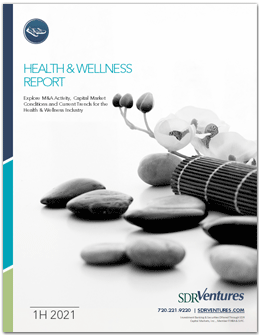
The health & wellness industry is broad – one of the broadest – and includes health supplements, nutraceuticals, wearable devices, and tech applications, all geared to helping people achieve and maintain good health. All of these subsectors, coincidentally, were also in the spotlight in 2020 during the global pandemic when people became more aware, and potentially concerned, about their health, while conflicted over stepping into a doctor’s office or hospital.
That’s understandable. Health officials did a thorough job of explaining the presence of COVID-19 and issuing stay-at-home orders. But the unintended consequence appears to have been a dramatic drop in so-called “ambulatory care,” traditional and non-emergency doctor visits. And while some may have been fearful of seeking care in a traditional setting, others may have been unable, as a widespread loss of jobs corresponded to a loss of health insurance. In surveys, U.S. physicians reported 60%-80% drops in patient visits.
Although patients shied away from doctors’ offices, they were also increasingly reminded of the importance of overall wellness, maintaining their immune system, and monitoring personal health. Nutritional supplements were poised to surge. As the pandemic spread, research found wearable fitness trackers designed to help people monitor general health may also help detect symptoms of COVID-19 and bolster public health efforts. And home health tech became a part of daily life: Global sales of non-contact infrared thermometers were expected to jump 55% by year’s end. Global sales of blood oxygen measurement devices (oximeters) are predicted to rise at a compound annual growth rate (CAGR) of nearly 7% between now and 2027, from a $1.75 billion industry to $3.1 billion…
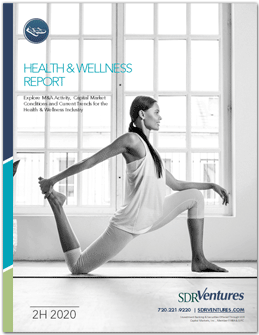
In the Health & Wellness sector – a broad consumer sector that includes nutritional supplements, fitness, and beauty care – 1H20 has been a double-edged sword. As consumers sought vitamin and mineral supplements to bolster their health during the COVID-19 pandemic or looked for ways to stay fit while socially distant, they were looking online instead of in traditional brick and mortar outlets.
For retail Health & Wellness, 2025 came five years early. The anticipated decline in brick and mortar retail has been accelerated by stay-at-home orders, virus-wary shoppers, and rapidly changing consumer habits. Just as Sears catalogs gutted hometown general stores at the dawn of the 20th Century, today’s sons of Amazon are reshaping the consumer landscape.
CHALLENGE: BRICK AND MORTAR NO MORE
For Health & Wellness brands that depend on physical location and foot traffic, an already challenging environment got tougher in the first half of the year. Traffic in shopping malls – long the home of supplement giant GNC and beauty supply chains such as Sephora – took a beating in a viral storm that could be the beginning of a death spiral. Malls closed for virus concerns, anchor department stores fell into bankruptcy and slashed locations in reaction to declining traffic. Without anchors as magnets, smaller mall retailers like those in Health & Wellness suffered. Ultimately the malls themselves struggled…
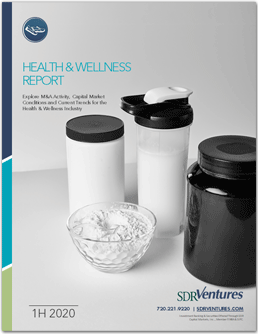
Perhaps more than in any other industry, M&A activity in the Health & Wellness industry is driven by the whims of consumer preferences. As younger generations embrace healthy living, preventive care and environmentally ethical lifestyles, expect the sector to continue to cater to those demands. SDR tracked 129 transactions across the industry in 2H 2019, and it is clear that the space has been active and a slowdown does not appear imminent.
As capital flows into the sector, two of the most active segments continue to be vitamins, minerals, and supplements manufacturers (think nutraceuticals, herbs, and powder supplements) and personal care products such as beauty and wellness products.
While there are examples of competitors using mergers as a platform to scale, much of the capital streams come from private equity and unrelated mega players (both public and private) looking to grow established brands. Both private equity and the mega players remain eager to tap into evolving consumer demand for products seen as more “natural,” organic, and environmentally responsible. Personal care company Burt’s Bees was an early example in both cases. No, it isn’t run by that bearded gentleman on the label, he was out of the business by 1999 and died in 2015. His cofounder sold 80% of the company to private equity in 2004 while expanding product lines, and in 2007 Burt’s Bees was acquired by publicly-traded Clorox for $925 million.
The demand is here. The money is here. The Global Wellness Institute pegs the global “wellness economy” at $4.5 trillion annually. Of that, the nonprofit Research and Education Institute reports physical activity accounts for about $828 billion and personal care/beauty tops $1 trillion…
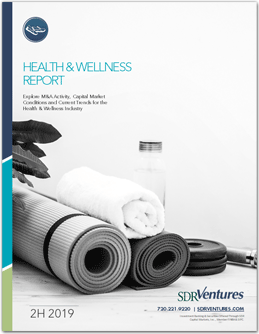
The first half of 2019 saw a continuation of robust M&A activity in the Health & Wellness Industry, as strategic acquirers have rapidly pursued inorganic growth strategies to position themselves more competitively in today’s saturated market. SDR tracked 67 transactions involving businesses participating in and serving the Health & Wellness sector. Most notably, the Natural & Organic Foods, Health & Fitness, and Vitamins, Minerals, & Supplements segments led the pack with 15 recorded transactions each including several noteworthy deals closed so far this year. The Personal Care segment also continues to experience significant acquirer interest, with 12 deals recorded in 2019, including the largest transaction in the industry year to date – JAB Cosmetics’ acquisition of an additional 20% stake in Coty for $1.7 billion in cash.
Strategic buyers and sponsor-backed platforms continue to dominate the M&A landscape in the Health & Wellness sector, accounting for three quarters of all activity so far this year. Although new sponsors are now increasingly seeking platform acquisitions from which to grow, as demonstrated by Swander Pace Capital’s investment in Bragg Live Food Products and TSG Consumer Partners’ acquisition of CorePower Yoga, industry participants continue to outpace pure funds in their pursuit of attractive targets.
The average EBITDA multiple for publicly traded Health & Wellness companies by the end of the first half of 2019 held steady since the end of 2018 at 12.5x LTM EBITDA. The Activewear segment traded at the highest average multiple of all segments at 15.2x EBITDA and the Vitamins, Minerals, & Supplements segment traded at the lowest multiple of 9.2x.
NATURAL & ORGANIC FOODS
The Natural & Organic Foods segment has been among the most active in the Health & Wellness Industry in the first half of 2019. With 15 recorded transactions so far this year, it is clear that this segment’s incredible compounded annual growth rate of over 11% since 2005 has bolstered M&A activity in the space. Some notable transactions involving Natural & Organic Food Products this year have been…
